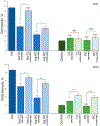Unsaturation in the Fatty Acids of Phospholipids Drastically Alters the Structure and Toxicity of Insulin Aggregates Grown in Their Presence
- PMID: 35580189
- PMCID: PMC9170185
- DOI: 10.1021/acs.jpclett.2c00559
Unsaturation in the Fatty Acids of Phospholipids Drastically Alters the Structure and Toxicity of Insulin Aggregates Grown in Their Presence
Abstract
Lipid bilayers play an important role in the pathological assembly of amyloidogenic proteins and peptides. This assembly yields oligomers and fibrils, which are highly toxic protein aggregates. In this study, we investigated the role of saturation in fatty acids of two phospholipids that are present in cell membranes. We found that unsaturated cardiolipin (CL) drastically shortened the lag phase of insulin aggregation. Furthermore, structurally and morphologically different aggregates were formed in the presence of unsaturated CL vs saturated CL. These aggregates exerted drastically different cell toxicity. Both saturated and unsaturated phosphatidylcholine (PC) were able to inhibit insulin aggregation equally efficiently. Similar to CL, structurally different aggregates were formed in the presence of saturated and unsaturated PC. These aggregates exerted different cell toxicities. These results show that unsaturated phospholipids catalyze the formation of more toxic amyloid aggregates comparing to those formed in the presence of saturated lipids.
Conflict of interest statement
The authors declare no competing financial interest.
Figures




Similar articles
-
Elucidating the Role of Lipids in the Aggregation of Amyloidogenic Proteins.Acc Chem Res. 2023 Nov 7;56(21):2898-2906. doi: 10.1021/acs.accounts.3c00386. Epub 2023 Oct 12. Acc Chem Res. 2023. PMID: 37824095 Free PMC article.
-
The degree of unsaturation of fatty acids in phosphatidylserine alters the rate of insulin aggregation and the structure and toxicity of amyloid aggregates.FEBS Lett. 2022 Jun;596(11):1424-1433. doi: 10.1002/1873-3468.14369. Epub 2022 May 13. FEBS Lett. 2022. PMID: 35510803 Free PMC article.
-
Miscibility of Sphingomyelins and Phosphatidylcholines in Unsaturated Phosphatidylcholine Bilayers.Biophys J. 2015 Nov 3;109(9):1907-16. doi: 10.1016/j.bpj.2015.09.009. Biophys J. 2015. PMID: 26536267 Free PMC article.
-
Cardiolipins and biomembrane function.Biochim Biophys Acta. 1992 Mar 26;1113(1):71-133. doi: 10.1016/0304-4157(92)90035-9. Biochim Biophys Acta. 1992. PMID: 1550861 Review.
-
Calorimetric and molecular mechanics studies of the thermotropic phase behavior of membrane phospholipids.Biochim Biophys Acta. 1999 Nov 16;1422(3):273-307. doi: 10.1016/s0005-2736(99)00099-1. Biochim Biophys Acta. 1999. PMID: 10548720 Review.
Cited by
-
Under Heparin-Free Conditions Unsaturated Phospholipids Inhibit the Aggregation of 1N4R and 2N4R Tau.J Phys Chem Lett. 2024 Aug 22;15(33):8577-8583. doi: 10.1021/acs.jpclett.4c01718. Epub 2024 Aug 14. J Phys Chem Lett. 2024. PMID: 39140785 Free PMC article.
-
Role of Saturation and Length of Fatty Acids of Phosphatidylserine in the Aggregation of Transthyretin.ACS Chem Neurosci. 2023 Sep 20;14(18):3499-3506. doi: 10.1021/acschemneuro.3c00357. Epub 2023 Sep 7. ACS Chem Neurosci. 2023. PMID: 37676231 Free PMC article.
-
Fatty Acids Reverse the Supramolecular Chirality of Insulin Fibrils.J Phys Chem Lett. 2023 Aug 3;14(30):6935-6939. doi: 10.1021/acs.jpclett.3c01527. Epub 2023 Jul 27. J Phys Chem Lett. 2023. PMID: 37498215 Free PMC article.
-
Concentration of Phosphatidylserine Influence Rates of Insulin Aggregation and Toxicity of Amyloid Aggregates In Vitro.ACS Chem Neurosci. 2023 Jun 21;14(12):2396-2404. doi: 10.1021/acschemneuro.3c00277. Epub 2023 Jun 6. ACS Chem Neurosci. 2023. PMID: 37279439 Free PMC article.
-
Nano-infrared analysis of amyloid β1-42 fibrils formed in the presence of lipids with unsaturated fatty acids.Nanoscale. 2023 Dec 14;15(48):19650-19657. doi: 10.1039/d3nr05184f. Nanoscale. 2023. PMID: 38019134 Free PMC article.
References
-
- Fitzner D; Bader JM; Penkert H; Bergner CG; Su M; Weil MT; Surma MA; Mann M; Klose C; Simons M Cell-Type- and Brain-Region-Resolved Mouse Brain Lipidome. Cell Rep 2020, 32, 108132. - PubMed
-
- Pope S; Land JM; Heales SJ Oxidative Stress and Mitochondrial Dysfunction in Neurodegeneration; Cardiolipin a Critical Target? Biochim. Biophys. Acta 2008, 1777, 794–9. - PubMed
MeSH terms
Substances
Grants and funding
LinkOut - more resources
Full Text Sources

